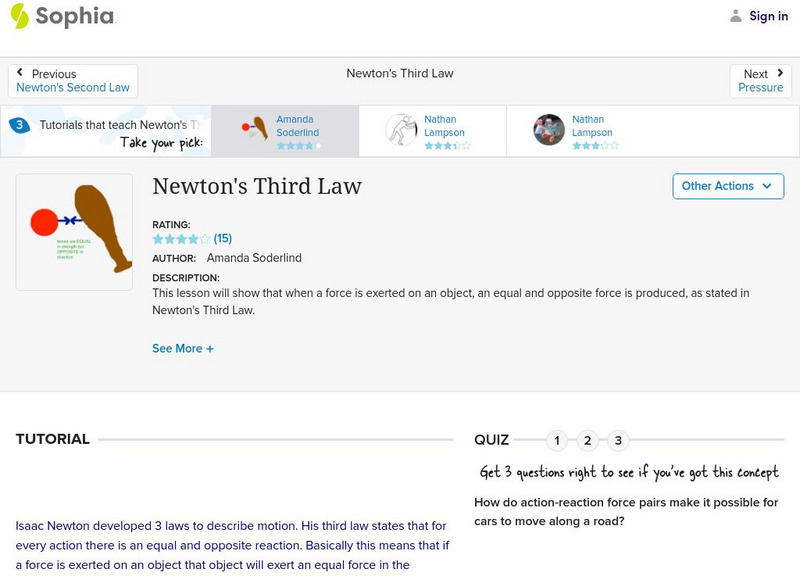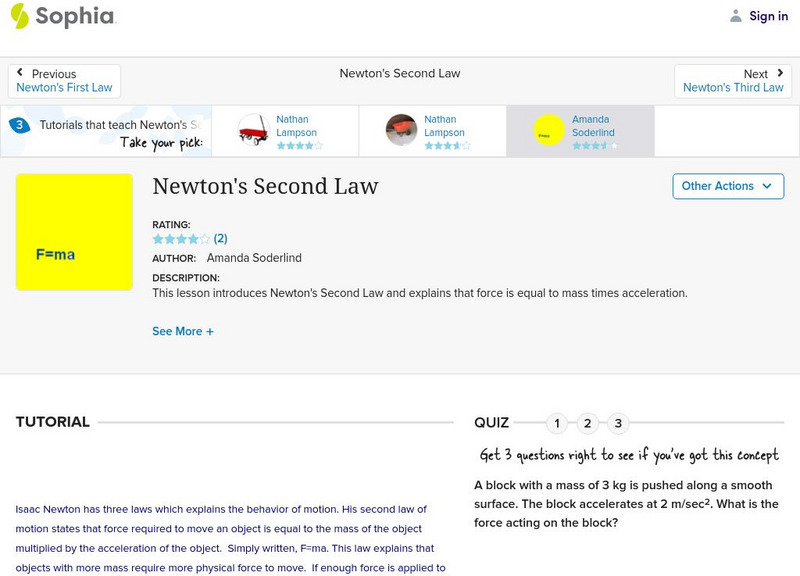Sophia Learning
Sophia: Newton's First Law: Lesson 2
This lesson introduces Newton's First Law, that inertia causes objects at rest to remain at rest, and objects in motion to remain in motion. It is 2 of 3 in the series titled "Newton's First Law."
Sophia Learning
Sophia: Newton's Third Law: Lesson 3
This lesson will show that when a force is exerted on an object, an equal and opposite force is produced, as stated in Newton's Third Law. It is 3 of 3 in the series titled "Newton's Third Law."
Sophia Learning
Sophia: Newton's Third Law: Lesson 1
This lesson will show that when a force is exerted on an object, an equal and opposite force is produced, as stated in Newton's Third Law. It is 1 of 3 in the series titled "Newton's Third Law."
Sophia Learning
Sophia: Newton's Second Law: Lesson 2
This lesson introduces Newton's Second Law and explains that force is equal to mass times acceleration. It is 2 of 3 in the series titled "Newton's Second Law."
Sophia Learning
Sophia: Newton's Second Law: Lesson 1
This lesson introduces Newton's Second Law and explains that force is equal to mass times acceleration. It is 1 of 3 in the series titled "Newton's Second Law."
Sophia Learning
Sophia: Mass & Acceleration: Lesson 1
This lesson explains why mass and acceleration are inversely proportional. It is 1 of 2 in the series titled "Mass & Acceleration."
Science Education Resource Center at Carleton College
Serc: Marble Stop
In this two-part lesson, students will discover that no matter what the shape of the track, the marble will rise to the same vertical height. They will begin to understand the concepts of gravity, motion, and force.
Science Buddies
Science Buddies: Teaching Engineering Design With an Egg Drop
Students build a device to protect an egg and prevent it from breaking when dropped.
McREL International
Mc Rel: Whelmer #9 Learning Activity: Nickel Karate
An easy to do activity that investigates the basic theories of inertia. The activity is in lesson plan format that meets NSES standards.
McREL International
Mc Rel: Whelmer #12 Learning Activity: Bernoulli Cans
An easy to do activity that investigates Bernoulli's principle. The activity is presented in lesson plan format that meets NSES standards.
Sophia Learning
Sophia: Placement of the Center of Mass
This lesson explains why the center of mass might not lie within an object.
TeachEngineering
Teach Engineering: What a Drag
Students learn about friction and drag - two different forces that convert energy of motion to heat. Both forces can act on a moving object and decrease its velocity. Students learn examples of friction and drag, and suggest ways to...
PBS
Pbs Learning Media: Newton's Triple Play: Baseball Science
In this lesson, students watch a video and animations that relate Isaac Newton's three laws of motion to baseball and apply what they've learned about these laws to another sport or other real-life situation.
Other
Ties Magazine: Marble Mania
This lesson idea is great for the middle school student. The challenge is to construct a marble maze or marble coaster where success is based upon the slow continuous motion of the marble.
McREL International
Mc Rel: Whelmer #33 Learning Activity: Density Balloon
A simple activity that investigates the effect of heat on the volume of a gas. The activity is presented in lesson plan format that meets NSES standards.
Physics Classroom
The Physics Classroom: Vectors: Non Horizontally Launched Projectile Problems
In this physics tutorial on vectors, the use of kinematic equations to solve non-horizontally launched projectiles is demonstrated.










